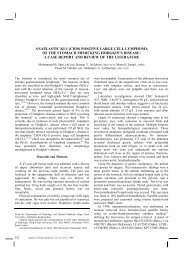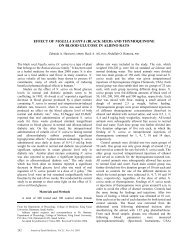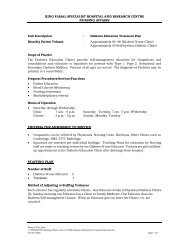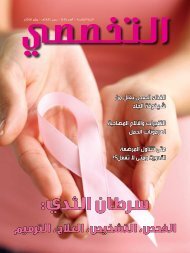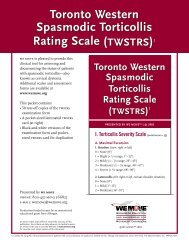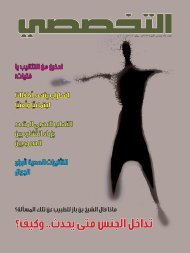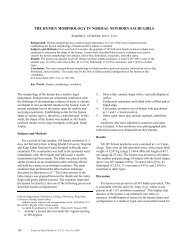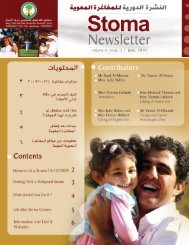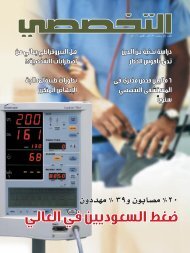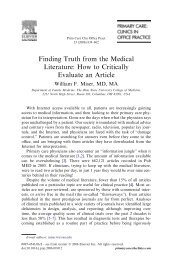CONGENITAL LIMB ANOMALIESFigure 1. Limb <strong>anomalies</strong> due to fetal causes (chromosomalaberrations).a) Bilateral cutaneous syndactyly <strong>of</strong> the little and ring fingers(arrow) and right little finger clinodactyly (arrow) in a short broadhand <strong>of</strong> a Down syndrome child (trisomy 21).b) Left preaxial polydactyly (arrow) in a newborn male withEdward’s syndrome (trisomy 18). Note the malformed low-set andposteriorly rotated ears, the micrognathia, the clenched hand,and the overlapping fingers.c) Left postaxial polydactyly (arrow) in a newborn male withpartial trisomy 13 (13q+). Other dysmorphic features includebulging forehead, blepharophimosis, deep-set eyes, depressednasal bridge, long philtrum, thin upper lip, and pectus excavatum.Figure 2. Showing <strong>limb</strong> <strong>anomalies</strong> due to fetal causes (singlegene disorders).a) Triphalangeal and distally displaced left thumb (short arrow)with thenar muscles hypoplasia, and preaxial polydactyly (longarrow) in an infant with the autosomal dominant triphalangealthumb polydactyly syndrome.b) Isolated preaxial polydactyly (arrow).c) Bilateral preaxial autosomal dominant synpolydactyly. Thesecond toe is duplicated and fused (arrows).224Ann Saudi Med 25(3) May-June 2005 www.kfshrc.edu.sa/annals
CONGENITAL LIMB ANOMALIEScases with Poland sequence and classified the hand<strong>anomalies</strong> into seven types according to severity <strong>of</strong>the deformity. Sirenomelia (vitelline artery steal) isanother example <strong>of</strong> vascular disruption leading toabnormal caudal development. 24 Five cases (7.1%) inthe present study suffered from <strong>limb</strong> <strong>anomalies</strong> dueto vascular disruption in the embryonic blood vessels.Vascular anastomoses and discordant placental bloodflow in twins with a common placenta predisposethem to vascular disruptions. In approximately 1%<strong>of</strong> monozygotic twins, intrauterine death <strong>of</strong> one twinmay result in release <strong>of</strong> thromboplastin or emboli tothe surviving co-twin leading to ischemia in localizedareas. 17 One patient in the present study hadgangrene and muscle atrophy <strong>of</strong> both lower <strong>limb</strong>s.He was one <strong>of</strong> a triplet. Other causes <strong>of</strong> vasculardisruption include placental infarction, maternal hypotension,vasoactive drugs, agents like cocaine andcertain medications. 17 e prenatal diagnostic technique,chorionic villus sampling (CVS), has also beenassociated with <strong>limb</strong> reduction defect, with anoxia <strong>of</strong>distal fetal structures as a postulated etiology. 39Infants <strong>of</strong> diabetic mothers have 6% risk <strong>of</strong> developing<strong>congenital</strong> malformations. e risk maybe over 20% if there is poor control during thefirst trimester. e malformations involve the heart(transposition <strong>of</strong> great vessels), anencephaly, spinabifida, holoprosencephaly, cleft lip and/or palate, renal<strong>anomalies</strong> and caudal regression sequence. 17 Onecase with caudal regression in the present study wasan infant <strong>of</strong> an uncontrolled diabetic mother.Twenty cases (28.6%) in the present study had<strong>limb</strong> <strong>anomalies</strong> as one <strong>of</strong> the manifestations <strong>of</strong> sporadicsyndromes (syndromes with unknown etiology).Acheiria (rudimentary hand and fingers) andaphalangia (transverse <strong>limb</strong> <strong>anomalies</strong>) are probablycaused by death <strong>of</strong> the mesenchymal cells in the <strong>limb</strong>bud region. 40 Ruiter et al 41 have described absent lefthand (a terminal transverse reduction defect) in aboy with mosaic trisomy 22. ey observed that thistype <strong>of</strong> <strong>limb</strong> <strong>anomalies</strong> has never been reported inassociation with this chromosomal aberration. isfinding points out the importance <strong>of</strong> genetics in thework-up in sporadic cases <strong>of</strong> <strong>limb</strong> <strong>anomalies</strong>.Watson 42 stressed that management <strong>of</strong> <strong>congenital</strong><strong>limb</strong> <strong>anomalies</strong> has to include classificationand etiology, incidence, diagnosis before birth,and counseling <strong>of</strong> parents. In a similar study doneby Holder-Espinasse et al 43 on 107 cases <strong>of</strong> <strong>limb</strong><strong>anomalies</strong>, the diagnosis was made in 78%, includingisolated, syndromic, or chromosomal <strong>anomalies</strong>with the conclusion that prenatal multidisciplinaryFigure 3 (a,b). Limb <strong>anomalies</strong> due to fetal causes (single genedisorders).A newborn boy with bilateral postaxial synpolydactyly <strong>of</strong> the ringfinger (short arrows) and bilateral preaxial synpolydactyly <strong>of</strong> thebig toe (long arrow).Figure 4 (a,b). Limb <strong>anomalies</strong> due to environmental causes.Limb <strong>anomalies</strong> due to amniotic band disruption: a) constrictionrings (arrow), syndactyly, and ectrodactyly or terminal phalangesamputations; b) Transverse <strong>limb</strong> defect, i.e. amputation <strong>of</strong> both feet.Ann Saudi Med 25(3) May-June 2005 www.kfshrc.edu.sa/annals 225



